Grinding poverty has long been a cause of migration and was the impetus again after the death of Mao Zedong in 1976. The story of migration since then is the story of modern China, as migrant workers have transformed China’s economy.
Kam Wing Chan of the University of Washington has compiled statistics which show that from 1990 to 2005—the most recent period for which reliable statistics are available—there was an overall gross migration across provinces of about 80m migrants (see map). An increasing number also migrate within their own province. All told, some 230m Chinese spend most of the year away from their home town or village. This is almost a third of all people globally estimated by the UN to be migrating within the borders of their own country.
Most migrants move in search of work. The number of rural Chinese working away from home is now almost 160m, or 12% of the country’s population. The Chinese government’s population-planning commission forecasts another 100m rural residents could move to cities by 2020. As migration patterns change, though expect to see rapid social and economic change across inland China.
economist.com/blogs




